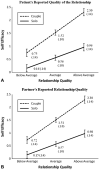Relationship and partner moderator variables increase self-efficacy of performing skin self-examination
- PMID: 18258332
- PMCID: PMC2894622
- DOI: 10.1016/j.jaad.2007.12.027
Relationship and partner moderator variables increase self-efficacy of performing skin self-examination
Abstract
Objective: We sought to identify relationship and partner-related moderating variables that influence the effectiveness of both a couples and a solo learning intervention designed to increase skin self-examination behavior in a sample of patients at risk for developing melanoma.
Methods: Patients received a brief intervention designed to teach skin self-examination skills and were randomly assigned into either a solo learning condition where the intervention was administered to the patient alone (n = 65) or a couple learning condition where the intervention was administered to the patient and patient's spouse or cohabiting partner (n = 65). The main outcome measure was skin self-examination self-efficacy, which is the strongest mediator of skin self-examination. The relationship moderator variables measured were quality of relationship, partner motivation, and ability to assist in implementation of the intervention.
Results: When quality of the marital/partner relationship was high, the beneficial effects provided by the partner being included in the skin self-examination skills training were the highest and patients exhibited higher self-efficacy. Similar effects were observed for those with partners who were motivated to implement the intervention, and for those with partners high in ability to provide support.
Limitations: Study limitations include the need to evaluate whether the effects can be sustained long term and the exclusion of patients with melanoma without partners.
Conclusions: The amount of beneficial effects gained by the patient from the skin self-examination intervention was influenced by marital/partner relationships. Clinicians may need to consider these relationship and partner characteristics when communicating to patients about skin cancer screening.
Figures




References
-
- American Cancer Society World Wide Web site Skin cancer facts. [Accessed April 1, 2007]. Available from: URL: http://www.cancer.org/docroot/PED/content/ped_7_1_What_You_Need_To_Know_...
-
- Rigel DS, Friedman RJ, Kopf AW, Polsky D. ABCDE–an evolving concept in the early detection of melanoma. Arch Dermatol. 2005;141:1032–4. - PubMed
-
- Berwick M, Begg CM, Fine JA, Roush CG, Barnhill RL. Screening for cutaneous melanoma by skin self-examination. J Natl Cancer Inst. 1996;88:17–23. - PubMed
-
- Berwick M, Oliveria SA, Luo S, Headley A, Rolognia JL. A pilot study using nurse education as an intervention to increase skin self-examination for melanoma. J Cancer Educ. 2000;15:38–40. - PubMed
-
- Borland R, Mee V, Meehan JW. Effects of photographs and written descriptors on melanoma detection. Health Educ Res. 1995;12:375–84. - PubMed

